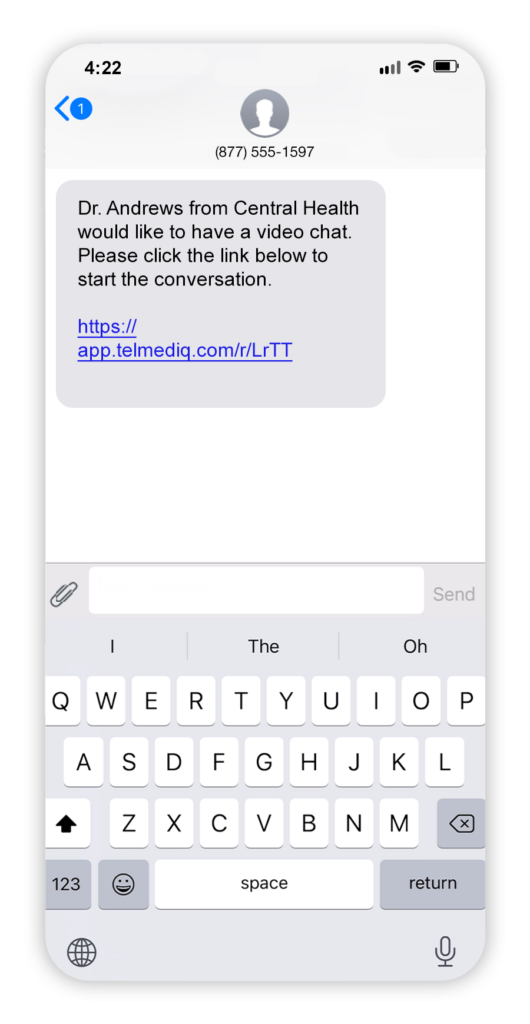Event
Why Integrations Matter for Clinical Communication
Watch NowTABLE OF CONTENTS

When medical staff book patient appointments over the phone, there’s no guarantee they’ll come.
We’re all patients, and we rely on our phones—a lot. According to research, 91.9% of patients agreed that text updates helped them avoid calling the office,1 so why not take advantage of this by engaging patients on their own devices?
The COVID-19 pandemic was a catalyst for changing patient expectations. Today, nearly half of patients expect more regular communication from healthcare organizations, with 7-in-10 agreeing they prefer to receive text messages for appointment confirmations, reminders, instructions, and test results.2
Considering text messages have a 98% open rate3 and that Americans check their phones an average of 160 times a day,4 it’s no surprise patients are moving away from other forms of communication with their providers. By comparison, emails have an average open rate of 12-25%, meaning any important care messages, instructions, and reminders that go to a patient’s email are much less likely to be read, remembered, and followed.
Roughly 20% of patients strongly considered changing doctors based on how they handled communication during the pandemic.5 That means it’s crucial to meet patients where they’re at to ensure they get the highest quality care possible.
Beyond changes caused by the pandemic, patients prefer texting for a variety of reasons. According to the University of Michigan Department of Family Medicine, “Texting may offer an efficient, inexpensive way to give a voice to people who aren’t often heard and whose needs aren’t always met.”6
Fewer than 25% of patients activate an account for their provider’s patient portal,2 meaning most of them have limited access to post-appointment notes, care instructions, appointment reminders, and other workflows that run through the portal. Patients just don’t like the hassle of using a web-based portal to access their care information.
That’s where texting comes in. Beyond basic appointment reminders, texts can be the medium for sharing post-appointment instructions, specialist referrals, medication adherence, and more.

Mobile phone usage transcends economic barriers. If a patient can’t access transportation, a reminder text message could give them time to get help from a rideshare program.
One medical provider sent three text reminders to inform patients of the Lyft vehicle picking them up, along with three more follow-up texts after the visit to ensure they arrived home safely. From this effort, patient show rates improved from 54% to 68%.8
These strategies reduce emergency department visits, especially if the clinic partners with social support services or similar rideshare programs. In addition, texting appointment reminders to patients with chronic conditions can help them stay on top of their needs and improve their road to recovery.
Patients are busy—they may be at work, with family, or unable to reach the medical office. When they can call and check on their appointment, medical staff may not be available to take the message. Texting an appointment reminder with a HIPAA-compliant system can significantly decrease those communication errors and missed calls.
Another way to alleviate this tension is to set up one-way text reminders for patient prescriptions and appointments. For more, read how one rehab practice used text reminders to reduce patient no-shows.
For the same reasons patients don’t like using portals to access information, they also like to avoid signing in to an application when they want to communicate with their provider.
Some patient engagement solutions allow clinicians to send a secure link to a patient’s phone that can be used to initiate telehealth appointments and/or allow a patient to inquire about their treatment. By receiving these secure links over text, patients are more empowered (and more likely) to be proactive with their health by directly interacting with their providers. Plus, it enables providers to text patients without receiving a flood of calls on their personal devices, helping to mitigate patient call volume.
Patients who are more engaged with their care experience better outcomes, as engaged patients are more likely to follow their care plan and take their medications as prescribed. This results in fewer complications, minimizes unnecessary visits, and helps to ward off emergency admissions.9 Here’s why text messaging is the future of patient engagement:
Sometimes, a patient needs care but can’t make it to the clinic. The use of telehealth appointments skyrocketed during the COVID-19 pandemic, drastically changing how patients expect to receive care.
Through HIPAA-compliant patient texting software, a patient can receive a secure telehealth link from their provider right to their cell phone. Because it comes in the form of a text message, patients are more likely to see it and engage with their provider and can do the telehealth appointment right from their phone.
Another example is how Lima Memorial uses a patient and family engagement solution to send text updates to patients’ family members for procedures. The workflow looks like this:

Once a patient is in the recovery room, the care team initiates a text to let the family know how the procedure went. The messages also inform family members that they can pick up their loved ones’ medication from the in-house pharmacy. Once patients can leave the clinic, their loved ones can take them straight home, medication in hand. Lima experienced a 10% increase in their patient experience scores as well.
Patient engagement trends can help you understand why patients do what they do, such as skipping appointments. Secure texts could be used to distribute patient satisfaction surveys, allowing for fast and easy responses from patients in a way that doesn’t require opening an email or using a portal.
Equipped with patient feedback, medical practice managers and hospital leaders can pinpoint areas of inefficiency and allocate resources to improve patient experiences and outcomes.
At Park Nicollet Hosptial, patient texting reduced readmission rates through a series of customized follow-up messages that assessed each patient’s risk for readmission. The hospital found that patients who received and responded to text messages were 32% less likely to be readmitted than those who were solely contacted by phone. Considering each readmission can cost a hospital up to $19,000,10 this isn’t just convenient for patients—it’s an effective way to help control costs.
Use Case: HIPAA-Compliant Care with a Simple Text

Imagine a patient messages their provider after hours, and it routes to the medical assistant on call who decides it’s a serious issue. After listening to or reading the message, the on-call clinician can quickly prepare a response.
A text to the patient might look like this: “Hey, I see you’re messaging me about your kidney test results. Can we hop on a quick video chat?”
The patient responds by text and approves (or the patient’s caregiver assists by granting approval). The patient may respond, “Yes, I can do that now. Please send me the link.”
After a secure link is sent, the patient taps the link, the internet browser launches, and they begin the video visit.
HIPAA-compliant texting offers two-way communication that can be initiated by the physician without requiring the patient to download an app or log in to a portal—the provider simply sends a text to the patient. The patient can then open the secure link to begin a video chat with the doctor or nurse on their mobile device.
HIPAA rules state that the law “does not prohibit the use of text messaging in healthcare. It is perfectly acceptable for doctors, nurses, and other healthcare professionals to communicate with each other—and even patients—via text message.”11
While true, certain protections and safeguards still need to be in place to maintain secure PHI, and the data must be encrypted. Using a secure platform to engage with patients through texting will reduce the friction of communication barriers for both healthcare providers and their patients.
Texting is here to stay, and you can utilize it to reduce costs, save time, and better engage patients. See this research guide on supporting value-based care initiatives for patients via secure texting, or connect with us today to learn more.
Sources: